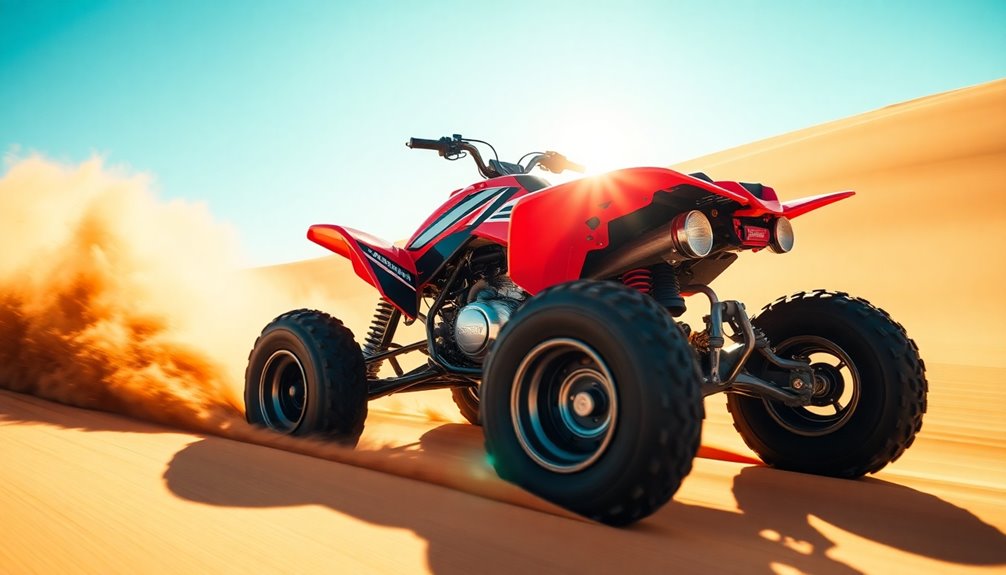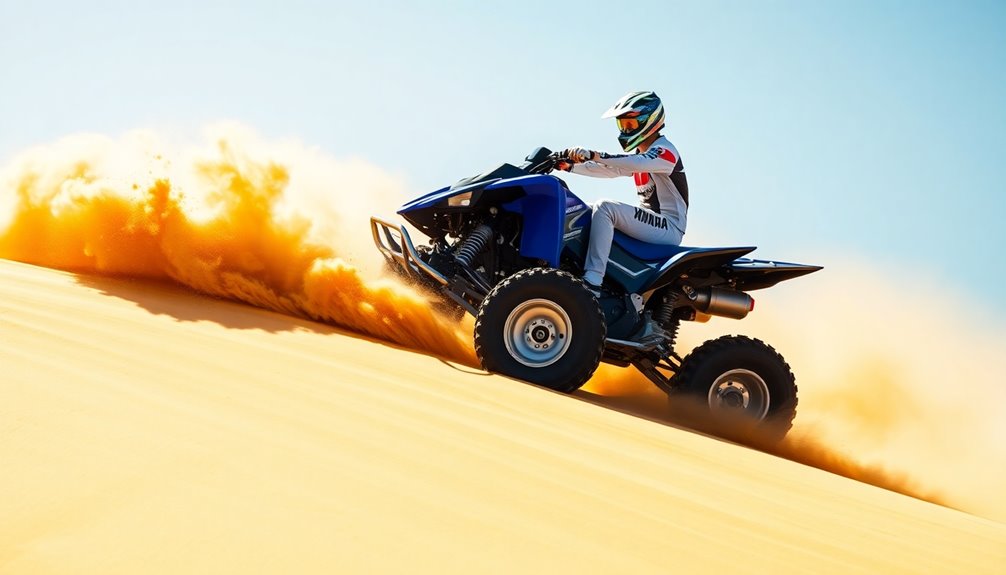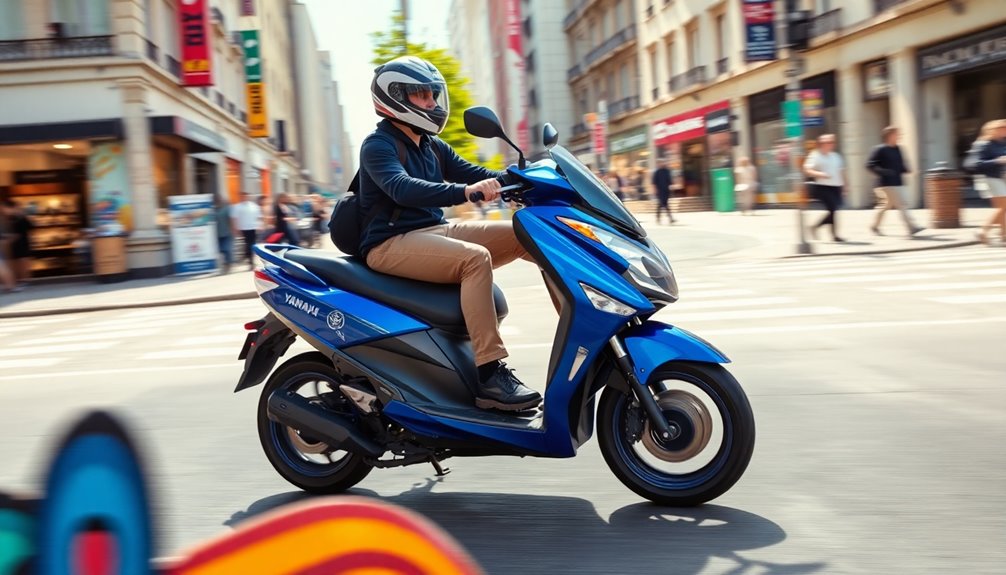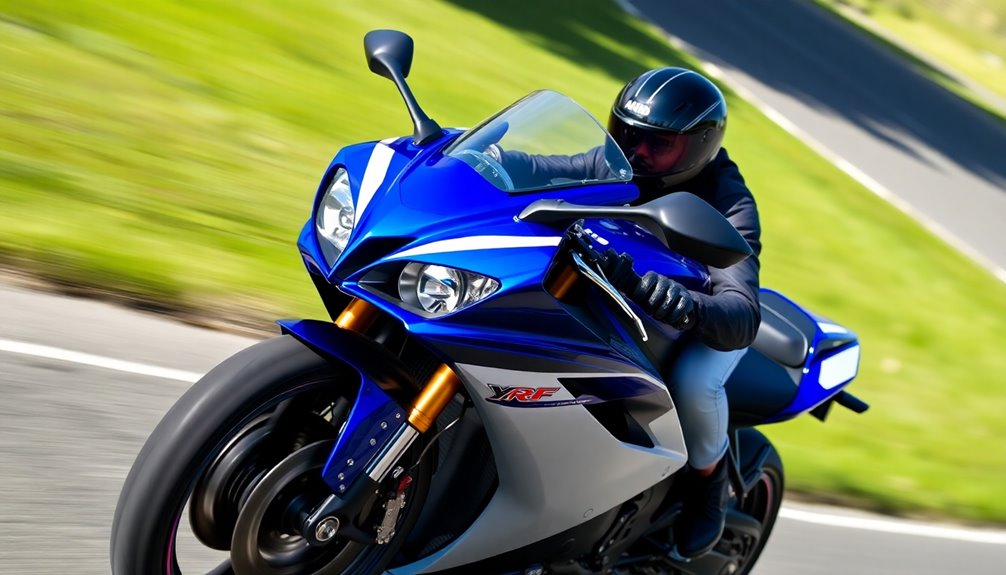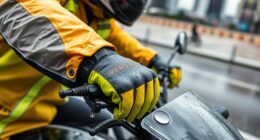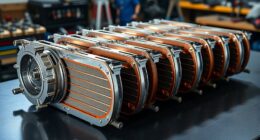The Yamaha Blaster is a small ATV with a big fun factor, reaching a top speed of about 55 mph in stock form. With its 195cc, air-cooled, 2-stroke engine delivering 17 horsepower, you'll enjoy a thrilling ride. This lightweight machine, weighing only 324 lbs, handles well on narrow trails and varied terrains. If you're eager to boost that speed, performance upgrades can push it to 60 mph, or even up to 80 mph with modifications. Whether you're a novice or a seasoned rider, you'll find plenty of excitement waiting, and there's so much more to discover about this dynamic ATV.
Key Takeaways
- The Yamaha Blaster features a 195cc, 2-stroke engine, providing a thrilling 17 horsepower for an exciting ride.
- Stock models reach speeds of approximately 55 mph, while modifications can push top speeds to 60 mph or more.
- Heavily modified Blasters can achieve impressive speeds of up to 80 mph, enhancing the fun factor for adrenaline seekers.
- With a lightweight design of 324 lbs and agile handling, the Blaster is perfect for navigating narrow trails and varied terrains.
- Its independent suspension system and comfortable riding features contribute to an enjoyable and exhilarating ATV experience.
Lightweight Design Enhances Maneuverability

When you hit the trails, the Yamaha Blaster's lightweight design makes all the difference in maneuverability. Weighing just 324 pounds, it's easy to handle, allowing you to navigate tight spots and make quick direction changes effortlessly.
With an overall length of 71.7 inches and a width of 43.3 inches, you'll find it compact enough to tackle narrow trails with confidence. The 4.3 inches of ground clearance lets you glide over various terrains without getting stuck, while the 43.3-inch wheelbase enhances stability during sharp turns. The 195cc, 2-stroke engine provides ample power for thrilling rides while maintaining a lightweight feel.
The enhanced suspension system further boosts your riding experience. The independent double wishbone front suspension offers 7.1 inches of travel, while the rear swingarm with monoshock provides 6.3 inches. This setup efficiently absorbs bumps, ensuring a comfortable ride as you zip through challenging landscapes.
With its simple yet rugged suspension design, the Blaster's lightweight frame works in harmony to deliver exceptional handling and stability.
Whether you're a novice or a seasoned rider, you'll appreciate how this ATV responds to your every command, making each adventure on the trails a thrilling experience.
Engine Efficiency Unleashed
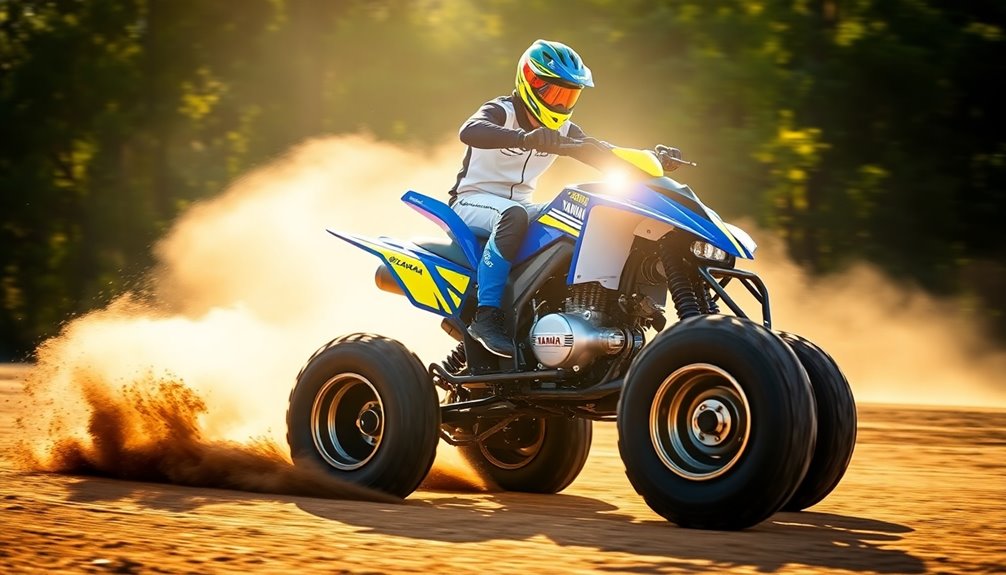
To unlock the Yamaha Blaster's true potential, you'll want to focus on maximizing speed and enhancing throttle response. Keeping an eye on tire pressure and tread condition can make a noticeable difference in performance. Additionally, understanding the engine specifications of the 195cc, air-cooled, 2-stroke engine can help you make informed modifications for better performance.
Maximum Speed of 50 Mph
The Yamaha Blaster showcases impressive engine efficiency, allowing for a maximum speed of 50 mph. With its stock 195cc, 2-stroke, single-cylinder engine generating 17 horsepower, you'll experience exhilarating rides that are both fun and thrilling. The stock 6-speed manual clutch transmission ensures you can effectively harness that power, making it easy to navigate various terrains. Additionally, the Blaster's 2WD Sealed O-Ring Chain drive train contributes to its agile handling and responsiveness on different surfaces.
While the top speed peaks around 55 mph, aftermarket modifications can enhance your ride, pushing it even further. Changes like pipes, porting, and jetting can improve overall performance, though they might only add a couple of mph to your maximum speed. Gearing and tire size play crucial roles too, so consider those if you want to maximize your ATV's potential.
Keep in mind that some factors limit the Blaster's top speed, such as its weight of 324 lbs and relatively low ground clearance of 4.7 inches. These elements affect acceleration and stability at high speeds.
Throttle Response Improvement
Improving throttle response in your Yamaha Blaster can significantly enhance your riding experience, making each twist of the throttle feel more immediate and powerful.
A key step is carburetor tuning; consider using a Mikuni VM24SS or similar carburetor for the optimal air-fuel mixture. Fine-tune the jetting to match your riding conditions and any modifications you've made. This ensures proper inlet tract air speed and precise metering without sacrificing fuel range.
Next, look into cylinder porting. This technique enhances the power band and extends piston life, but it's crucial to have experienced technicians perform the work to maintain reliability. Additionally, the Blaster's 195cc two-stroke engine is known for its ease of modifications, making it a popular choice for enthusiasts.
Make sure the ported cylinders and heads are matched for proper squish clearance and compression ratio.
Upgrading your exhaust system can also lead to noticeable improvements. Choose an aftermarket system like the Pro Tec to achieve a broad and strong powerband, while balancing high-rpm performance with mid-range needs.
Lastly, optimize your ignition timing. Utilizing a CDI ignition system ensures reliable spark delivery, helping maintain symmetrical operating temperatures and preventing overheating.
These modifications will unleash your Blaster's engine efficiency, making every ride exhilarating.
Tire Pressure and Tread Condition
Tire pressure and tread condition play a crucial role in your Yamaha Blaster's performance and efficiency. To get the most out of your ride, always check the manufacturer's recommended tire pressure in your owner's manual.
For all-purpose trail riding, aim for 7-8 psi. If you're tackling soft terrain like wet sand or mud, lower it to 6-8 psi, while for dry sand, keep it between 8-10 psi. On hard surfaces, increase to 10-12 psi for better handling. Lower pressures enhance tire grip on varied terrain, allowing for improved performance.
Maintaining the right tire pressure enhances traction, allowing your tires to dig into the ground, which improves acceleration. However, lower pressures can decrease puncture resistance, so avoid sharp objects. Additionally, be mindful that regular filter maintenance of your air purifier can significantly enhance air quality, creating a better riding environment.
Regularly inspect your tread condition; worn or damaged tires can compromise safety and performance. A flat tread profile is crucial for stability, while a curved profile may work better in softer terrains.
Don't forget that optimal tire pressure can reduce engine load, enhancing fuel efficiency and overall performance. Make tire pressure and tread checks part of your routine maintenance to keep your Yamaha Blaster running at its best.
User Feedback Highlights Performance
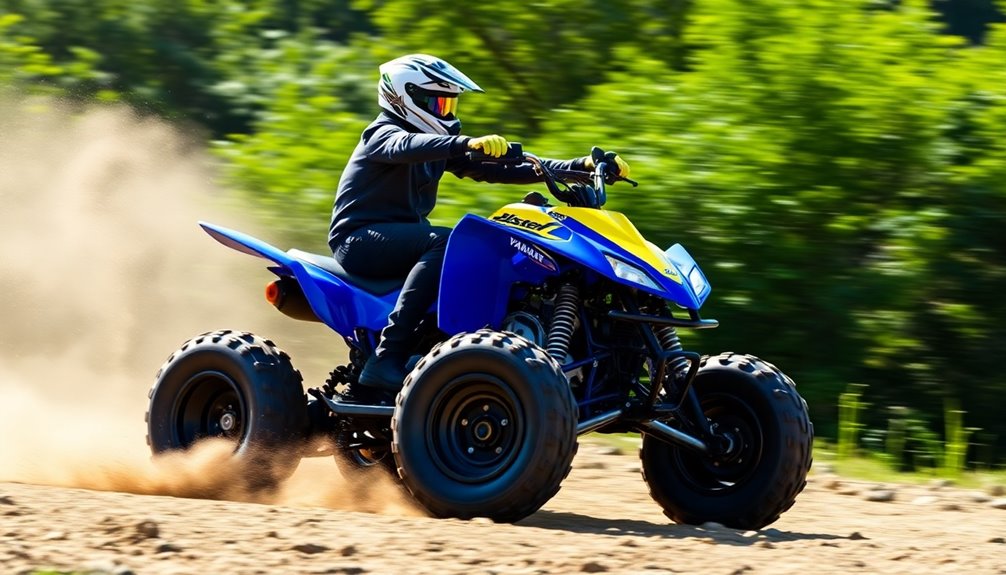
Many Yamaha Blaster owners rave about the performance enhancements achieved through various modifications. Engine upgrades like porting can boost max RPMs by up to 300, giving you that extra edge.
Adding a performance pipe typically raises your top speed by 2-3 mph, a noticeable difference when you hit the trails. If you're looking for more power, big bore kits can help you handle larger tires and higher gearing, enhancing overall performance. Achieving 75+ mph requires extensive modifications, making it a challenging yet rewarding goal for enthusiasts.
Gearing adjustments also play a crucial role. By changing your gear ratios, like switching from stock 13/40 to something like 14/38, you can significantly impact both your top speed and low-end performance.
Larger tires can help you reach higher speeds, but don't forget they may sacrifice some low-end power. Tire size is vital too; going with smaller tires improves low-end acceleration, while larger ones can elevate your top speed.
With hydraulic disc brakes and improved suspension options, you can enhance not just speed but handling and safety as well. These modifications, according to user feedback, make the Yamaha Blaster a thrilling ride tailored to your preferences.
Owner Insights: Performance Feedback

Yamaha Blaster owners frequently share their experiences, highlighting how various modifications can transform their ride. Many enthusiasts report that with a few aftermarket tweaks, like upgrading the exhaust and intake, you can push your max RPMs up by 300, netting an extra 2-3 mph on top of the stock top speed of 55 mph.
Some owners have even claimed speeds over 80 mph with extensive modifications, showcasing the potential of this small ATV. The Blaster's 17 horsepower, 195cc engine provides a solid power band, especially when ridden aggressively. You'll feel the rear sliding through turns, a thrill reminiscent of the old three-wheelers.
However, don't overlook tire size and gearing; they play a crucial role in achieving higher speeds and can often yield better results than engine mods alone. Wind resistance can significantly impact maximum speed, especially on varied terrain, making it essential to consider your riding conditions.
While the Blaster lacks modern features like reverse or electric start, its lightweight design and ease of modification keep the fun factor high. You'll appreciate its agility and performance on trails, making it a favorite among recreational riders. The community values the unique ride experience, proving that sometimes less really is more.
Market Share Analysis

In the competitive landscape of the global ATV and UTV market, Yamaha faces significant challenges and opportunities.
With the market valued at USD 16.21 billion in 2022 and projected to grow to USD 29.23 billion by 2030, the industry is on an impressive trajectory, boasting a CAGR of 6.8% from 2023 to 2030.
Although specific market share figures for Yamaha aren't highlighted, historical data indicates fluctuations over time, underscoring the competitive nature of the segment.
Key players like Polaris, BRP, Honda, and Kawasaki dominate the field, adding to the competitive pressure.
The increasing popularity of adventure sports and the introduction of electric models represent growth factors, but there's also a shift toward larger, more powerful ATVs that could impact Yamaha's smaller models, including the Blaster.
Regional analysis reveals North America as a vital market, emphasizing the need for Yamaha to adapt to diverse consumer preferences. Electric vehicles' introduction is expected to further influence market dynamics, urging Yamaha to innovate in this eco-friendly segment.
As you explore the market dynamics, consider how Yamaha's ability to innovate and meet the evolving demands of ATV enthusiasts will play a crucial role in its market share moving forward.
Performance-Boosting Exhaust Systems
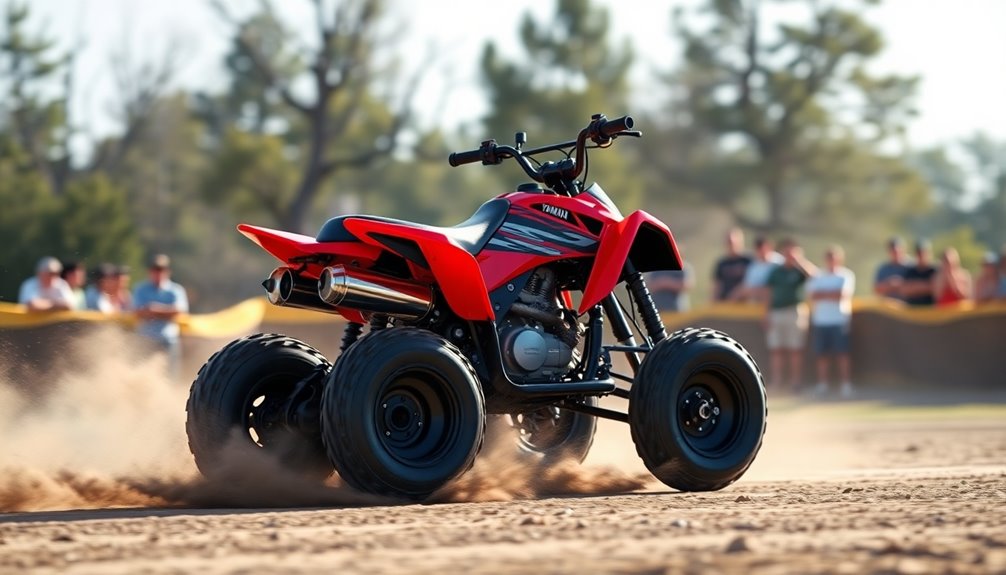
Upgrading to a performance-boosting exhaust system can significantly enhance your Yamaha Blaster's overall performance. By improving exhaust gas flow, these systems allow for better combustion efficiency, ultimately leading to increased power output.
You'll notice optimized engine tuning, maximizing both horsepower and torque, especially when paired with other modifications like porting and carb upgrades. Toomey Racing USA offers a variety of high-performance racing exhaust systems specifically designed for Yamaha Blaster models.
There are various types of exhaust systems available, including polished chrome and factory finish options. Whether you choose a full exhaust kit, silencer kit, or pipe set, each is specifically designed for the Yamaha Blaster.
Many kits come with necessary carburetion tuning parts and air filtration, ensuring a comprehensive upgrade.
While the stock Blaster can reach a top speed of around 55 mph, combining exhaust mods with adjustments to gearing and tire size can push that to 60-62 mph.
Although engine modifications may enhance acceleration rather than top speed directly, they still contribute significantly to your riding experience.
Just remember, if you're aiming for those higher speeds, suspension upgrades will be essential.
With detailed installation support and quality assurance, you can tackle your upgrade with confidence.
Cost Range and Dealer Locations
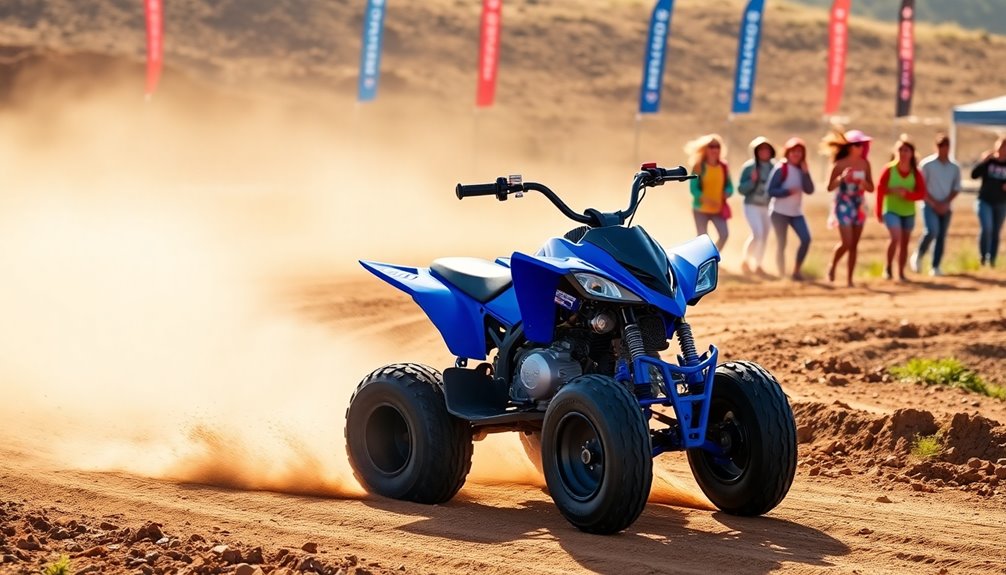
When considering modifications and performance upgrades for your Yamaha Blaster, understanding the cost range and where to find one is important. In the used market, you can typically expect to pay between $2,000 and $3,000 for a good condition Blaster, depending on the year and overall state.
This ATV is an affordable choice compared to others in its class, and prices may vary based on your location and supply. Units often sell quickly, so it's wise to act fast. For approximate retail and trade-in values, check resources like Kelly Blue Book.
You can find Yamaha Blasters at several dealer locations. Pasadena Yamaha in California is a dedicated Yamaha dealer, while Del Amo Motorsports in Los Angeles may help with inquiries. A wide range of accessories is also available for the Yamaha Blaster at various dealers, enhancing its appeal.
Don't forget to explore local dealerships and specialized powersports stores in your area, as they might've stock or valuable information. Additionally, online marketplaces and forums are great places to connect with other enthusiasts looking to buy or sell.
With these options, you'll be well-equipped to find a Blaster that suits your needs and budget.
Youthful Thrill-Seekers and Beginners
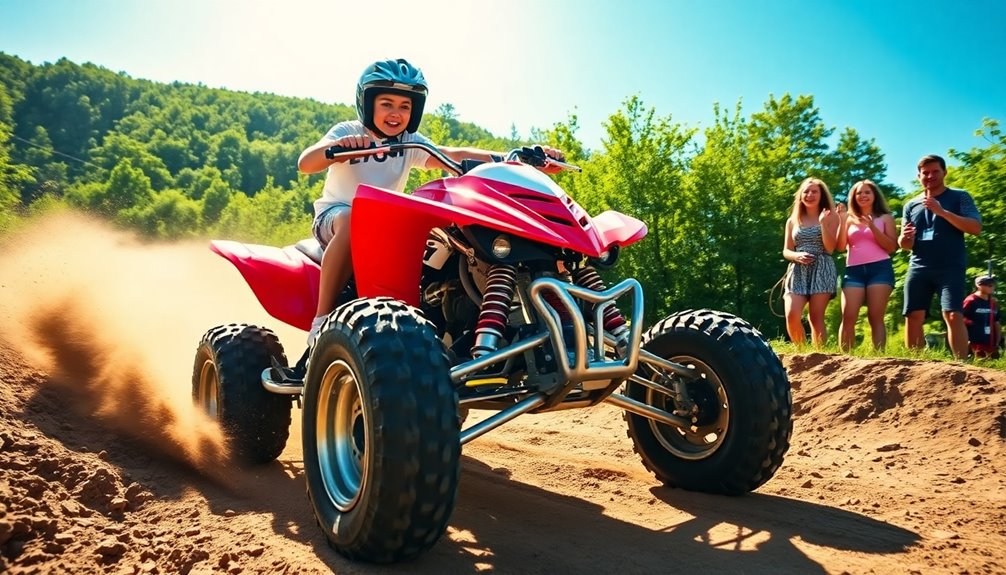
The Yamaha Blaster is an excellent choice for youthful thrill-seekers and beginners eager to dive into the world of off-road riding. Weighing in at just 265 pounds, its lightweight frame and compact dimensions make it easy to handle, whether you're navigating tight trails or wide-open spaces.
The responsive handling, combined with independent double wishbone front suspension, provides a smooth ride with 7.1 inches of travel, ensuring you'll tackle various terrains confidently. Additionally, the Blaster's quick-revving engine allows for rapid acceleration, making it even more thrilling for novice riders.
This ATV is designed with beginners in mind. The oil injector system means you won't have to worry about premixing fuel and oil, while the kick-start system gets you going with just a couple of kicks.
Plus, the two-stroke engine is relatively easy to maintain, and affordable aftermarket parts allow for easy performance upgrades as you gain experience.
With a quick acceleration from its 195cc engine and a top speed of around 55-60 mph, the Blaster offers both excitement and versatility.
Safety features like hydraulic disc brakes, headlights, and serrated footpegs ensure a secure ride as you explore the thrills of off-road adventure.
Frequent Electrical System Failures

Frequent electrical system failures can be a frustrating experience for Yamaha Blaster owners, as they often disrupt your riding adventures. One common issue stems from source coil problems, where the ground side can lose its soldered contact or a small wire may break. If you face incorrect resistance readings, it might just be a broken wire rather than a need for a complete coil replacement.
CDI and stator malfunctions also contribute to electrical headaches. CDI units can fail, requiring replacement, while stator issues might lead to no spark or intermittent problems. The resistance of the source coil measured at 190-240 ohms can also indicate underlying issues with the electrical system.
Diagnosing these electrical failures can be tricky, as multiple components may interact in complex ways. Wiring and connection problems add another layer of difficulty. Small wires can break, and grounding issues can impact the entire system. It's crucial to ensure that all connections are secure and that specific wiring configurations are followed.
Lastly, the diagnostic challenges can't be ignored. Intermittent faults make pinpointing issues tough, often leading to trial and error with different components. Having specialized tools and expertise can make a significant difference in resolving these electrical headaches.
Emphasizing Robust Safety Features
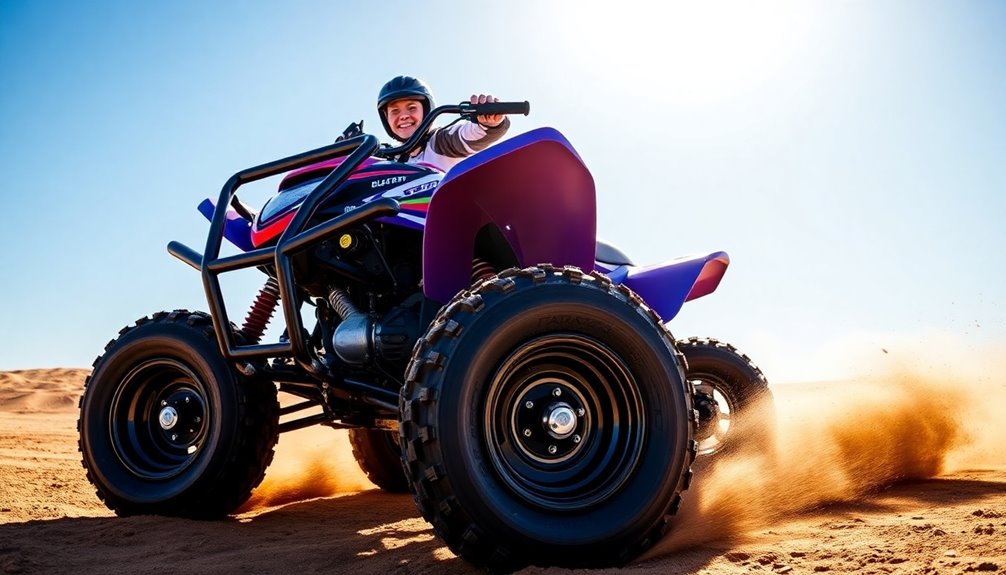
Yamaha Blaster owners can take comfort in the robust safety features designed to enhance their riding experience, especially after dealing with electrical issues. The dual hydraulic disc brakes at the front and a hydraulic disc brake at the rear ensure reliable stopping power across various terrains. Plus, the brake wear indicator signals when it's time for a replacement, keeping maintenance straightforward.
With a 195cc, air-cooled engine, you can also install an engine stop lanyard for added security, allowing an adult to remotely shut off the engine if necessary. The CDI ignition system and optional exhaust port restrictor help control performance, making it safer for younger riders. Additionally, the presence of parental controls allows for monitoring and restricting ATV use, ensuring a safer experience for younger enthusiasts.
Visibility is critical, and the Blaster doesn't skimp here. Equipped with head and taillights, it also allows for a safety flag attachment for better visibility in obstructed areas. Reflective materials enhance visibility in low-light conditions, making nighttime rides safer.
Finally, the sturdy frame, independent double wishbone front suspension, and a comfortable seat height contribute to a stable ride. Always remember to wear protective gear like helmets and gloves to maximize your safety while enjoying the thrill of the ride.
Impressive 50 Mph Top Speed
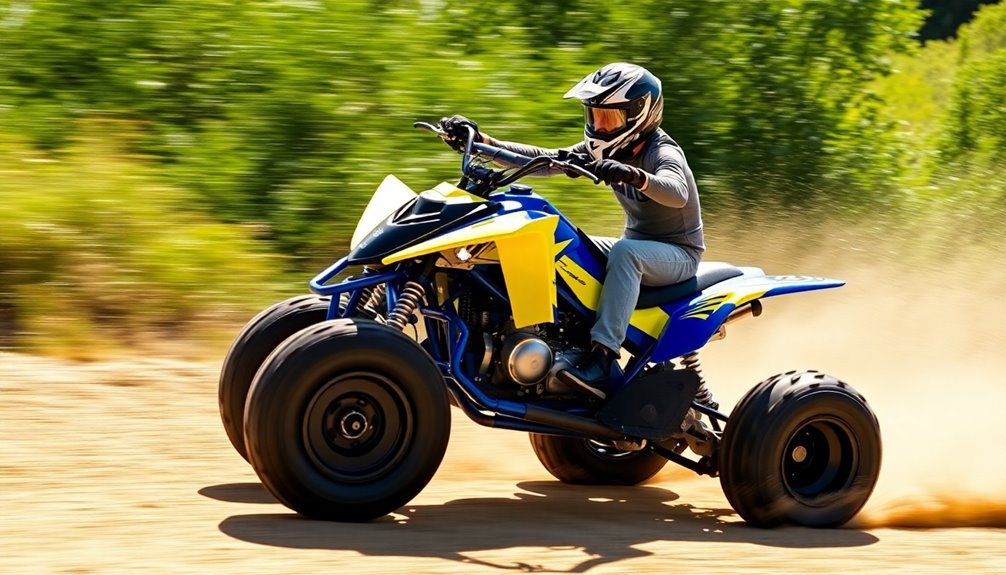
While the stock configuration of the Blaster offers an impressive top speed of around 55 mph, many riders find that the thrill of pushing these limits is part of the adventure. This speed is consistent across various sources and applies to the standard setup, making it a reliable performer for both novice and experienced riders.
However, if you're looking to break past that barrier, there are options available. With a few modifications, such as a big bore kit and an aftermarket exhaust, you might inch closer to a top speed of 58-60 mph.
Keep in mind, though, that achieving speeds above this usually requires significant upgrades, including gearing changes and suspension enhancements. The stock tires and gearing can limit your potential, so consider larger rear tires for better performance. Additionally, weight reduction strategies can significantly impact top speed, allowing for even greater performance from the ATV.
In real-world testing, heavily modified Blasters have reached speeds around 58-62 mph, showcasing the ATV's potential with the right adjustments.
Ultimately, while the Yamaha Blaster excels in agility and handling, its impressive top speed makes it a fun and thrilling ride that invites you to explore its limits.
Frequently Asked Questions
What Is the Weight Limit for the Yamaha Blaster?
The Yamaha Blaster doesn't have an officially stated weight limit, but it's designed for riders weighing up to around 200 pounds for optimal performance.
If you're heavier than that, the ride may feel less stable and could affect handling.
Always consider the terrain and your riding style too, as those factors can impact the overall experience.
It's best to prioritize safety and comfort while enjoying your time on the Blaster.
How Does the Blaster Compare to Other ATVS in Its Class?
When you compare the Yamaha Blaster to other ATVs in its class, you'll notice it stands out for its lightweight design and nimble handling.
It accelerates quickly from a stop, often keeping pace with larger models when ridden aggressively. While it may not sustain high speeds like some competitors, its modification potential allows you to enhance performance significantly.
The Blaster's affordability and fun factor make it an appealing choice for newcomers and experienced riders alike.
What Maintenance Is Required for the Yamaha Blaster?
To keep your Yamaha Blaster running smoothly, you'll need to follow a regular maintenance schedule.
Change the transmission oil annually, clean the air filter every 20-40 hours, and check the spark plug every six months.
Don't forget to lubricate the drive chain often.
Inspect the brakes, suspension, and throttle operation every six months as well.
Lastly, keep an eye on the fuel line and exhaust system for any wear or damage.
Is the Yamaha Blaster Suitable for Beginners?
Yes, the Yamaha Blaster's a great choice for beginners. Its lightweight frame and compact chassis make it easy to handle, while the responsive 195cc engine offers quick acceleration without overwhelming you.
The hydraulic disc brakes ensure you can stop safely, and the low seat height accommodates shorter riders. Although it has a kick-start system, which can be tricky, the overall design and features support a fun and manageable riding experience for newcomers.
Are There Customization Options Available for the Blaster?
Yes, there are plenty of customization options available for the Blaster.
You can enhance performance with big bore kits, aftermarket cylinders, and clutch kits.
For suspension, you can swap in shocks from models like the Yamaha Banshee or Raptor, adjusting as needed.
Don't forget about chassis upgrades—front wheels and rear hubs are interchangeable with several Yamaha models.
With the right modifications, you'll significantly boost your ride's performance and handling.
